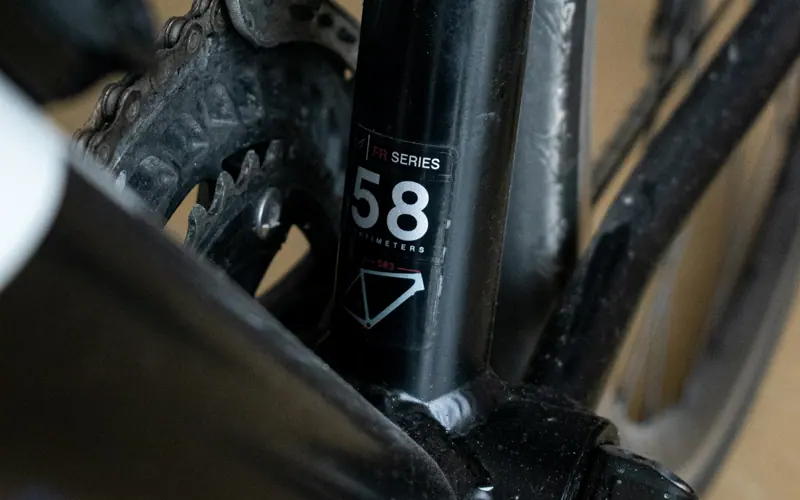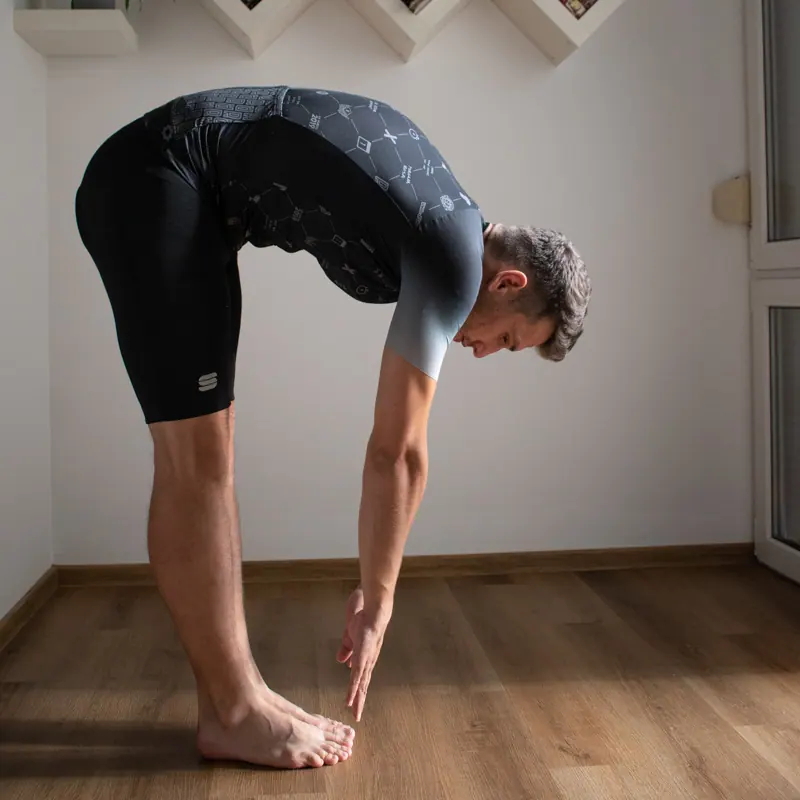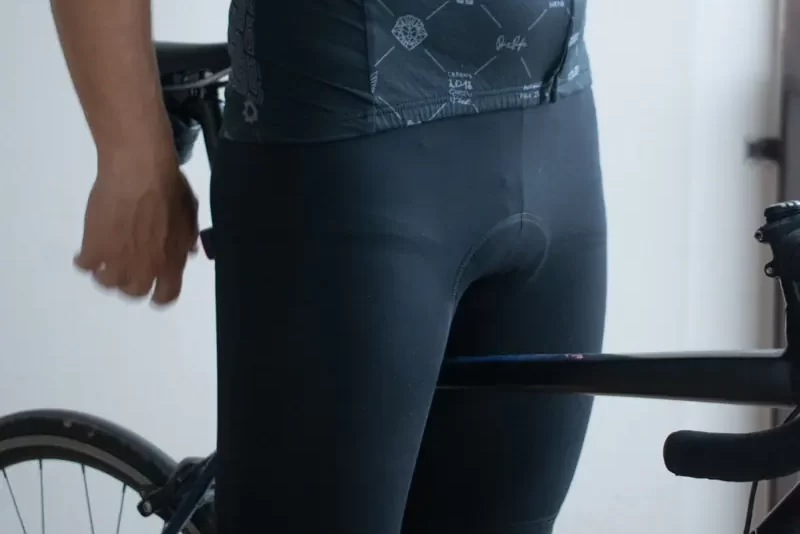Cyclists are often between frame sizes when buying a new bike. I was too when and there was a question if it’s better to buy a bigger or smaller size. After doing almost no research, I bought the wrong size. I don’t want you to make the same mistake, so I did some research for you to help you pick the correct size.
When you’re between frame sizes, it’s better to buy the smaller size. You can always make it bigger by replacing the stem and raising the handlebar and a seat. Making a bigger bike smaller is more difficult, as there is only so much you can do. A smaller frame also gives you more control when riding.
Cyclists come in all shapes and sizes with various preferences. It’s hard to give a one-fit-all answer, so that’s why I will provide you with some guidance and tests that will help you make the right decision.
Which frame size is better?
Picking the correct frame size can be a nightmare. Each manufacturer has its own chart. Some will give you the size in centimeters, others in letters, and some in inches. In the end, you are even more confused than you were at the beginning.

When you finally figure out your target frame size, you are most likely between frame sizes. Most of us are, so you need to decide whether to go one size bigger or one size smaller. It’s a tough call to make, after all, there is a large amount of money on the line.
Fortunately, we live in the internet age where all the information is available in a matter of seconds, including this one.
I will always tell you to go with a smaller frame as I made the mistake of picking a bigger one. Don’t get me wrong, it’s still an OK bike, but I know it could be even better, and more importantly, I could have a better time on every ride.
So without further ado, let me present to you the pros and cons of each frame size.
Smaller frame size
PROS
- Can be enlarged by adjustments to individual parts
- More control
- More fun to ride
- More responsive
- Stiffer
CONS
- Cyclist needs to be more flexible
- Less comfortable
- More pressure on hands, elbows, mid-back and neck
There is no doubt that smaller bikes give you more control, are easier to handle and give you more enjoyment, especially on a descend. However, not everybody can ride them, as they are also less comfortable, and older and less flexible cyclists might find them too uncomfortable to ride.
I’m not the most flexible guy in the world, but I have the youthful mobility to ride a smaller bike. In a few years, that might be gone, but until then, I will be buying smaller frames as they give you a better riding experience. It’s that simple.
I absolutely love descends (as most do), and every bike that gives me extra control when going downhill is worth the money. I know that making a few adjustments can make a smaller bike a perfect fit for me while the control remains almost intact. By having a larger frame, the control is never there in the first place.
Smaller frame offers more control, but is less comfortable.
I need to address the cons as well. I already talked about flexibility, so if you’re not flexible enough, go with a larger frame. It will make your rides more comfortable as your position on a bike will be more upright, almost enduro-like.
A smaller frame also puts more pressure on certain body parts, but that’s also true for a larger frame- it’s just that the pressure is elsewhere.
Don’t pick a smaller frame just because pro cyclists use them. They are willing to suffer for hours to gain small advantages. You don’t need those advantages on your rides.
When riding a smaller frame, the pressure is increased on the hands and elbows as your position on a bike is more aggressive with more weight transferred forward onto your arms. The aggressive position also makes you bend your neck much more than in an upright position, exposing you to potential neck pains.
Last but not least, the shorter distance between the seat and the handlebar makes you bend your back a bit. If you’re flexible, that shouldn’t be a problem, but for most amateur cyclists, it might be. Staying in that position for a few hours might lead to some mid-back pain.
Bigger frame size
PROS
- More comfortable
- More upright position
- Better for cyclists with disproportionate limbs
CONS
- Harder to adjust to cyclists’ needs
- Less control
- More pressure on shoulder joints and lower back
A bigger frame gives you everything a smaller frame doesn’t have, but it also takes away everything it does have.
The main and only advantage that would convince me to buy a larger frame is comfort. And that’s a big one. There’s no denying that larger frames are more comfortable, but only if adjusted correctly. A larger frame with a more upright position can become very uncomfortable if something is not adjusted properly, like having a handlebar too far away or too low.
But there’s a catch. Larger frames allow you to make them smaller only so much, and if you’re on the lower limit, chances are, the adjustments won’t even be possible. And then you can say bye-bye to the extra comfort.
You can’t fix a bike that’s too big.
When we talk about choosing a frame size, we always imagine a perfect man with a body of ideal proportions. Like a Vitruvian Man of cycling. The reality is that not many of us are like that.
Some cyclists have longer legs, others have longer arms, and others have long bodies with shorter limbs. If you have a disproportional body, especially if you have a longer limb, then choosing a larger frame is a good idea.
Imagine a short guy with long arms. Based on his height, he should buy a smaller frame, but because of his long arms, his reach is too long for a small frame. He would be the most uncomfortable cyclist on the planet. Choosing a larger frame would solve this problem, and by lowering the seat, he would reach the ground as he should.
There isn’t a one-fit-all answer. It’s up to each individual to find what’s best for him and how he can adjust the bike to fit him.
Test to help you decide frame size
There are some easy tests that you can make at home that will help you decide between a bigger and smaller frame. However, take the results with caution as they only give you some guidance. Testing each frame size is always the best solution.
Flexibility test

The easiest test to do is the flexibility test. All you have to do is bend over and try to touch your toes with your hand.
If you can touch them or come close, you are flexible enough to ride the smaller frame. The further you are from your toes, the more likely you will need to make minor adjustments to the bike.
If you are far away from your toes, like even above the ankles, a bigger frame is the right choice for you.
Standover height

Standover height is a simple indicator of whether a bike is too big for an individual. A cyclist steps over a top tube with a seat behind him. His feet must be flat on the ground and a bike between his legs in an upright position.
You want to see a bit of distance between the top tube and the crotch. If your crotch is touching the top tube, the bike is too big for you.
You can also measure standover height without the bike.
- Stand next to a wall, with the back touching it.
- Place a book between your legs, with the top touching your crotch.
- Step aside with the book still touching the wall.
- Mark the highest point of the book
- Measure the distance between the floor and the mark. This is your standover height.
Ape index

The ape index is a ratio between your arm span (or wingspan) and height. It’s believed that most people have a ratio of 1, meaning their arm span is the same as their height.
If you have a ratio greater than 1, meaning your arm span is larger than your height, then you should choose the big frame. If you have a ratio below 1, a small frame is for you.
The handlebar is further away from the saddle on a bigger frame, so longer arms are preferable.
Take the test ride
No home test will be as efficient in determining whether you need a smaller or bigger frame as taking them both on a test ride.
Most bike shops offer a test ride which you should absolutely do. I don’t mean a few minutes of riding in a car park but a proper ride where you will really get the feel of the bike.
You will notice that one size will fit better, it will feel right. My wife tested the big frame size first and was satisfied, but once she sat on a smaller frame, she just knew that this was the bike for her.
If the bike fits, you will know in a matter of minutes. I still recommend taking it for a ride before purchasing, but even a few minutes on a bike will give you an idea if this bike is for you.
Adjustments that will help you get to the correct size
If you are between frame sizes, it’s a real possibility that you will buy a frame that is either a bit too small or a bit too big. But luckily, you can make adjustments that will make the bike fit you perfectly.
Stem
The most common adaptation is stem replacement. This is mainly done on smaller frames, where cyclists fit a longer stem to extend the reach, making their position on the bike more comfortable.
On bigger frames, the story is the other way round. Riders fit shorter stems and thus reduce the reach.
Saddle height
Cyclists compensate for the smaller frame size by raising the saddle. This increases the distance between the saddle and the pedals, allowing the rider to fully extend the leg while pedaling.
With a bigger frame adjusting the saddle height is much more difficult. You can only lower it to a certain extent. Further lowering is impossible, and the only solution is to buy a smaller bike.
Handlebar height
The handlebar can also be raised if necessary. This is done mainly by riders on smaller bikes, allowing them to position themselves less aggressively. It’s also a way to make the smaller bike more comfortable for less flexible cyclists.
The handlebar can be raised by adding or moving headset spacers above or below the stem. The more spacers under the stem, the more upright the position on the bike.
With bigger bikes, the height adjustment is limited. Most cyclists that choose a bigger frame want to lower the handlebar, but this can only be done to a certain extent.
So once again, we proved that having a smaller frame offers more adjustment possibilities.
Conclusion
Many cyclists find themselves between frame sizes, having to choose wheater to buy a bigger or smaller frame. It’s a decision that can be costly if not made correctly, so extensive research and testing is advised.
I recommend buying a smaller frame, as it offers more adjustment possibilities which compensate for the smaller size. It also provides better control and handling, making your rides more enjoyable.
However, smaller bikes tend to be less comfortable, so older or less flexible cyclists should consider getting a bigger frame.
You can do some simple tests at home that will help you decide which size to buy, but at the end of the day, you really should take both sizes on a test ride and decide based on your feelings. Every cyclist is different and will have different preferences.


